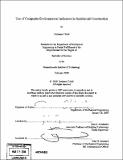| dc.contributor.advisor | John E. Fernández. | en_US |
| dc.contributor.author | Hall, Terianne C | en_US |
| dc.contributor.other | Massachusetts Institute of Technology. Dept. of Mechanical Engineering. | en_US |
| dc.date.accessioned | 2008-11-07T18:51:49Z | |
| dc.date.available | 2008-11-07T18:51:49Z | |
| dc.date.copyright | 2008 | en_US |
| dc.date.issued | 2008 | en_US |
| dc.identifier.uri | http://hdl.handle.net/1721.1/43011 | |
| dc.description | Thesis (S.B.)--Massachusetts Institute of Technology, Dept. of Mechanical Engineering, 2008. | en_US |
| dc.description | Includes bibliographical references (p. 33-34). | en_US |
| dc.description.abstract | As a result of the damage caused by hurricane Katrina in August 2005, fifty percent of New Orleans residential housing was destroyed or severely damaged. A systems model is being developed at MIT for promoting resource efficient housing in New Orleans. The model attempts to capture the urban metabolism of the city by tracking the material and energy flows required of various possible reconstruction scenarios. The model is meant to act as a tool for policy makers to identify the most effective construction methods for a green city. Currently, the model is programmed to provide output values for material use, energy consumption and labor hours during the construction, use, and end-of-life phases of portions of the city's housing stock. While these quantitative results are useful for specialists to understand a given scenario, they are not useful for policy makers. My thesis project will focus on comparing the merits and drawbacks of applying various standard indicators to New Orleans construction methods. This includes, but is not limited to, Gross Domestic Product per capita and Species Diversity. Next, my work with this project will focus on assessing existing composite indicators based on their relevance to the model and their usability by policy makers. Understanding the merits and downfalls of various composite indicators will allow policy makers to choose an appropriate metric for comparing construction option, and make informed decisions about incentive programs for the various stages of reconstruction in New Orleans. It is the intention of the project to find indicators that can be generalized for use in other locations in conjunction with future models of urban metabolism yet to be developed. | en_US |
| dc.description.statementofresponsibility | by Terianne C. Hall. | en_US |
| dc.format.extent | 34 p. | en_US |
| dc.language.iso | eng | en_US |
| dc.publisher | Massachusetts Institute of Technology | en_US |
| dc.rights | M.I.T. theses are protected by
copyright. They may be viewed from this source for any purpose, but
reproduction or distribution in any format is prohibited without written
permission. See provided URL for inquiries about permission. | en_US |
| dc.rights.uri | http://dspace.mit.edu/handle/1721.1/7582 | en_US |
| dc.subject | Mechanical Engineering. | en_US |
| dc.title | Use of composite environmental indicators in residential construction | en_US |
| dc.type | Thesis | en_US |
| dc.description.degree | S.B. | en_US |
| dc.contributor.department | Massachusetts Institute of Technology. Department of Mechanical Engineering | |
| dc.identifier.oclc | 240638134 | en_US |
